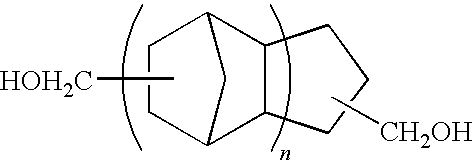Polymer of polycarbonate diol having an alicyclic structure and production process thereof
a polycarbonate diol and alicyclic technology, applied in the field of polycarbonate diol polymer, can solve the problems of poor flexibility, poor flexibility of polyurethane, poor flexibility, etc., and achieve the effects of flexible and heat resistance, high reliability in long-term insulating performance, and well-balanced manner
- Summary
- Abstract
- Description
- Claims
- Application Information
AI Technical Summary
Benefits of technology
Problems solved by technology
Method used
Image
Examples
example 1
[0054]In a reaction vessel equipped with a stirrer, thermometer and fractionating column, 785.2 g (4.00 mol) of tricyclodecane methanol, 360.32 g (4.00 mol) of dimethyl carbonate and 520 mg of tetra-n-ethoxytitanium were placed and reaction was conducted at a temperature of 90 to 140° C. while distilling off methanol by-produced in the reaction. After distillation of the methanol was almost completed, the reaction was continued for further 8 hours under a pressure reduced to 10 mmHg or less. The reaction was conducted in a nitrogen atmosphere.
[0055]After completion of the reaction, the reaction liquid was cooled and a pale yellow solid was obtained at room temperature. The product was confirmed to be a polymer of polycarbonate diol by GPC and NMR analyses. The number average molecular weight of the product was 824.
example 2
[0056]In a reaction vessel equipped with a stirrer, thermometer and fractionating column, 1049.56 g (4.00 mol) of pentacyclopentadecane dimethanol (manufactured by MARUZEN PETROCHEMICAL CO., LTD.), 360.32 g (4.00 mol) of dimethyl carbonate and 520 mg of tetra-n-ethoxytitanium were placed and reaction was conducted at a temperature of 90 to 140° C. while distilling off methanol by-produced in the reaction. After distillation of the methanol was almost completed, the reaction was continued for further 8 hours under a pressure reduced to 10 mmHg or less. The reaction was conducted in a nitrogen atmosphere.
[0057]After completion of the reaction, the reaction liquid was cooled and a colorless transparent liquid was obtained at room temperature. The product was confirmed to be a polymer of polycarbonate diol by GPC and NMR analyses. The number average molecular weight of the product was 1823.
example 3
[0058]In a reaction vessel equipped with a stirrer, thermometer and fractionating column, 392.6 g (2.00 mol) of tricyclodecane dimethanol, 236.36 g (2.00 mol) of 1,6-hexanediol, 360.32 g (4.00 mol) of dimethyl carbonate and 40 mg of tetra-n-ethoxytitanium were placed and reaction was conducted at a temperature of 95 to 160° C. while distilling off methanol by-produced in the reaction. After distillation of the methanol was almost completed, the reaction was continued for further 4 hours under a pressure reduced to 10 mmHg or less. The reaction was conducted in a nitrogen atmosphere.
[0059]After completion of the reaction, the reaction liquid was cooled and a colorless transparent liquid was obtained at room temperature. The product was confirmed to be a polymer of polycarbonate diol by GPC and NMR analyses. The number average molecular weight of the product was 2390.
PUM
| Property | Measurement | Unit |
|---|---|---|
| mol % | aaaaa | aaaaa |
| temperature | aaaaa | aaaaa |
| temperature | aaaaa | aaaaa |
Abstract
Description
Claims
Application Information
 Login to View More
Login to View More - R&D
- Intellectual Property
- Life Sciences
- Materials
- Tech Scout
- Unparalleled Data Quality
- Higher Quality Content
- 60% Fewer Hallucinations
Browse by: Latest US Patents, China's latest patents, Technical Efficacy Thesaurus, Application Domain, Technology Topic, Popular Technical Reports.
© 2025 PatSnap. All rights reserved.Legal|Privacy policy|Modern Slavery Act Transparency Statement|Sitemap|About US| Contact US: help@patsnap.com



